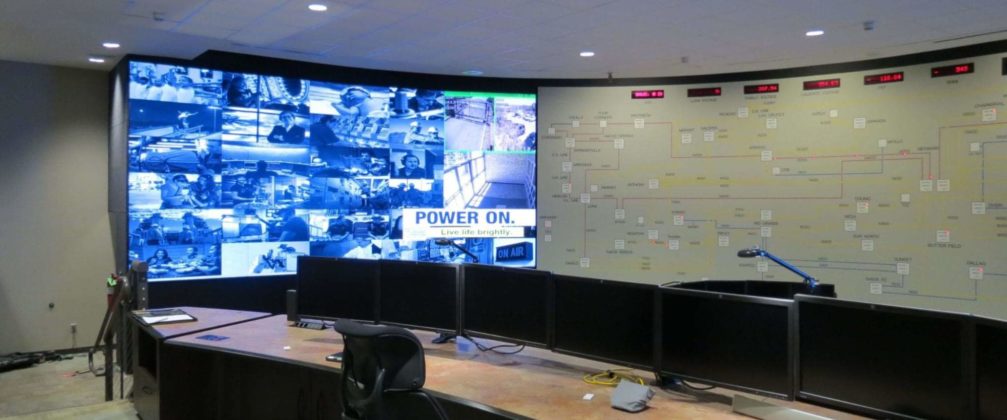When it comes to the daily operation of control rooms, few factors are more important than big data, the Industrial Internet of Things (IIoT), and artificial intelligence (AI). These elements play a key role in how operators perform their jobs and how organizations function on a larger scale. Let’s explore big data control room technologies, the IIoT, and AI to gain a better understanding of their impact on control rooms in a variety of industries.
Big Data Control Room Technologies
Big data is defined as large, complicated data sets that are beyond the abilities of traditional databases in terms of display, management, and latency. This data enters control rooms in a wide variety of formats at rapid speeds and must be analyzed and acted upon in near-real-time. Big data is typically stored using storage area networks (SANs) and media asset management (MAM) software.
“The Three Vs”
Big data can be broken down into three parts: volume, velocity, and variety. Let’s take a closer look at each of these characteristics:
- Volume. This refers to the volume of information that comprises big data, which comes from a myriad of sources.
- Velocity. This refers to the extreme speed at which big data is created, collected, and processed.
- Variety. This refers to the different types of big data, including structured, semi-structured, and unstructured.
Structured, Semi-Structured, and Unstructured Data
As one of “the three Vs,” variety plays a major role in how big data is utilized in control room environments. As we mentioned above, there are three types of big data: structured, semi-structured, and unstructured. Here’s what each of these terms means:
- Structured data is housed in traditional databases and can be processed and analyzed in a fixed format.
- Semi-structured data can be both structured and unstructured, but it often doesn’t contain a table definition.
- Unstructured data comes from a variety of text sources and often requires special handling before it can provide any value.
Sources of Big Data
Big data comes from a wide variety of sources, which contributes to its extreme volume. While having many sources is beneficial to organizations, it can also be difficult for them to match, cleanse, and share information. Here are some of the main sources of big data:
- Cameras
- Cloud data sources
- Dashboards
- Data lakes
- Emails and text documents
- Industrial Internet of Things-connected devices
- Medical devices
- Security systems
- Sensors
- Social media
- Static images
- Video and audio files
- Wearables

How Big Data Benefits Operators
Big data control room technologies enhance operators’ situational awareness and allow them to make informed decisions in real-time. As the number of data streams continues to grow, operators must have crucial information at their fingertips on both light and dark sky days. They must also be able to monitor and share an ever-expanding amount of data sources with individuals within and beyond the control room environment. When harnessed properly and displayed using top-of-the-line video walls, big data makes that possible.
How Big Data Benefits Organizations
Along with benefitting operators, big data can play a key role in improving an organization’s overall operations. Organizations that harness the power of big data can improve how they obtain, store, share, and utilize information across their teams. For example, government agencies can use big data to manage utilities, prevent crime, avoid traffic congestion, and run agencies more smoothly.
You’ll find a handful of the ways that big data benefits organizations below:
- Operational efficiency. Big data allows organizations to anticipate future demands, leading to cost and time reductions. It also allows them to make better decisions in line with market demand.
- Predictive maintenance. By determining the root causes of failures and issues in near-real-time, big data helps operators react quickly and efficiently. This facilitates low-cost, predictive maintenance that minimizes downtime.
- Preventing security breaches. The insights provided by big data can also allow organizations to detect fraudulent behavior before it affects them.
The Industrial Internet of Things (IIoT)
The Industrial Internet of Things (IIoT) is similar to the traditional Internet of Things (IoT) due to its focus on cost optimization and operational efficiency. Both IoTs achieve these goals by automating instrumentation and reporting by making objects “smart.”
The stakes are much higher with the IIoT, which is composed of machines and devices in industries where system failures and unexpected downtime can have life-threatening consequences. These industries include the transportation, energy, and industrial sectors, among others. The IIoT is typically facilitated by machine-to-machine (M2M) communication, machine learning, and big data.
How the IIoT Impacts Organizations
The IIoT has significantly impacted security operations centers (SOCs) and network operations centers (NOCs). These organizations must be able to accommodate “smart” technologies to take full advantage of every available data source. The IIoT also plays a key role in organizations’ operational technology, which can include everything from human-machine interfaces (HMIs) to supervisory control and data acquisition (SCADA) systems.
How the IIoT Benefits Organizations
The IIoT allows organizations to monitor, gather, share, and analyze big data in an efficient and cost-effective manner. In turn, they can develop valuable insights that allow them to make smarter, faster decisions. Using the IIoT also provides organizations with growth opportunities due to the proliferation of “smart” data.
Here are a few more ways that the Industrial Internet of Things can benefit a wide variety of organizations:
- Identifies system failures before they occur with predictive analytics to minimize downtime.
- Reduces costs through analysis of historical data for more cost-efficient operations.
- Keeps workers and end users safe by warning them before a dangerous event occurs.

The Relationship Between AI and Big Data
A branch of computer science, artificial intelligence (AI) enables “smart” machines to perform tasks that require human intelligence. AI is facilitated by machine learning and, when completely optimized, can facilitate fully-automated decision making. This allows “smart” devices to learn from past experiences and make the right choices in real-time.
AI-equipped machines must be able to recreate the reasoning and thought processes of humans to maximize their value. In most cases, they perform repetitive tasks with large quantities of data without the need for constant operator guidance. Ultimately, the proliferation of big data (and its increasing complexity), has given AI a key role in the daily operations of many organizations.
How Artificial Intelligence Benefits Operators & Organizations
The rise of big data has put much more pressure on operators when it comes to processing, analyzing, and acting on information. Many organizations simply don’t have the bandwidth to handle the volume, velocity, and variety of big data. That’s where artificial intelligence comes in.
Devices outfitted with AI and machine learning can be trained to identify anomalies and pinpoint opportunities. They can also sort through vast quantities of information and present operators with only the most relevant data points. This saves them time and effort, while also boosting their situational awareness and ability to make informed decisions.


